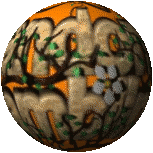A very long time ago when I was a young girl my mother came home with a bag. Being curious, I asked her what the bag contained. A wide smile beamed from her face as she pronounced it was some ‘Monkey Musk.’ She opened the bag to show me quite a large root of a soft-green fleshy plant with beautiful bell like flowers. Each flower was bright yellow and marked with red spots – indeed both the shape of the flower and the spots did appear to resemble the face of a monkey. From that very second – I have always loved ‘Monkey Musk.’

The spots on this particular specimen are not quite as large as those that were on my mother’s plant. This particular version, although widely available in Garden Centres and Nurseries is predominantly wild and is often found beside water.
There are also many dwarf versions that are usually brightly coloured but are all either red, orange, yellow or watery red as a background petal colour. Some of the dwarf versions contain spots others are just one colour.
Earlier this year whilst on a visit to Little Heath Nurseries, I found an Orange Sorbet Monkey Musk plant and thought that this would make a nice addition to my garden.

Orange Sorbet Monkey Musk
I usually try and visit these particular nurseries when I can as not only do they often have some unusual plants but there is a shop attached to the nursery that is like an Aladdin’s Cave. It is full of unusual and wonderful household and gardening items and is worth a visit for anyone who may be in the vicinity or nearby.





























































































